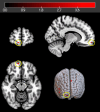Functional but Not Structural Brain Changes After Olfactory Training in Women With COVID-19-Associated Olfactory Dysfunction
- PMID: 40152156
- PMCID: PMC12082003
- DOI: 10.1002/lary.32128
Functional but Not Structural Brain Changes After Olfactory Training in Women With COVID-19-Associated Olfactory Dysfunction
Retraction in
-
RETRACTION: Functional but Not Structural Brain Changes After Olfactory Training in Women With COVID-19-Associated Olfactory Dysfunction.Laryngoscope. 2025 Jul 12. doi: 10.1002/lary.32397. Online ahead of print. Laryngoscope. 2025. PMID: 40650558
Abstract
Background: Olfactory training (OT) is a recommended treatment for olfactory loss and has proven effective in clinical contexts, yet its effects on the central-nervous system remain unclear. This study aimed to investigate the functional and structural brain changes in patients with post-viral olfactory loss undergoing OT.
Methods: Twenty patients with post-viral olfactory loss and 19 healthy controls underwent OT for 3 months. All participants were assessed using the Sniffin' Sticks test and magnetic resonance imaging (MRI). Voxel-based morphometry and olfactory bulb volumetry were performed on structural images. Presenting an unpleasant odor, n-butanol, in a canonical block design, functional MRI was performed using whole-brain and region of interest analyses.
Results: Patients with post-viral olfactory loss showed significant improvement following OT. Enhanced functional activations were observed in the orbitofrontal cortex and parahippocampus, while OT had little or no effects on brain structures.
Conclusion: The present findings suggest that OT provides early perceptual and functional benefits, with structural changes potentially emerging later with extended training duration.
Keywords: COVID; MRI; olfactory loss; olfactory training; smell.
© 2025 The Author(s). The Laryngoscope published by Wiley Periodicals LLC on behalf of The American Laryngological, Rhinological and Otological Society, Inc.
Conflict of interest statement
The authors declare no conflicts of interest.
Figures



References
Publication types
MeSH terms
Grants and funding
LinkOut - more resources
Full Text Sources
Medical

